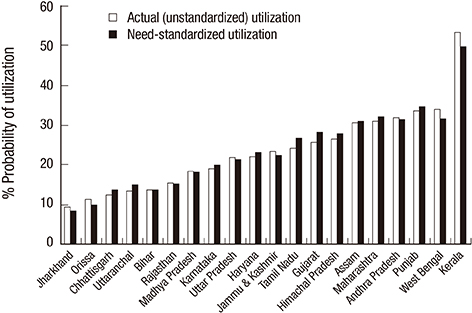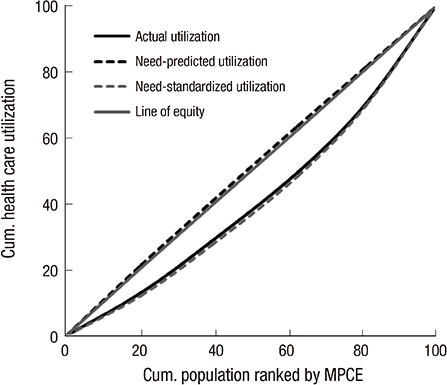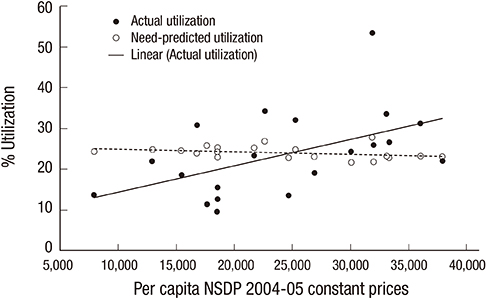J Korean Med Sci.
2015 Nov;30(Suppl 2):S155-S166. 10.3346/jkms.2015.30.S2.S155.
Horizontal Inequity in Elderly Health Care Utilization: Evidence from India
- Affiliations
-
- 1Institute of Economic Growth, University of Delhi Enclave, Delhi, India. william@iegindia.org
- 2Jawaharlal Nehru University, New Mehrauli Road, New Delhi, India.
- 3Department of Social and Behavioral Sciences, Harvard T.H.Chan School of Public Health, Boston, Massachusetts, USA.
- KMID: 2351154
- DOI: http://doi.org/10.3346/jkms.2015.30.S2.S155
Abstract
- Against the backdrop of population aging, this paper presents the analysis of need-standardised health care utilization among elderly in India. Based on nationally representative morbidity and health care survey 2004, we demonstrate that the need for health care utilization is indeed pro-poor in nature. However, the actual health care utilization is concentrated among richer sections of the population. Further, the decomposition analysis reveals that income has a very strong role in shifting the distribution of health care away from the poor elderly. The impact of income on utilization is well-demonstrated even at the ecological-level as states with higher per capita incomes have higher elderly health care utilization even as the levels of need-predicted distribution across these states are similar. We also find that the distribution of elderly across social groups and their educational achievements favours the rich and significantly contributes to overall inequality. Nevertheless, contribution of need-related self-assessed health clearly favours pro-poor inequality. In concluding, we argue that to reduce such inequities in health care utilization it is necessary to increase public investments in health care infrastructure including geriatric care particularly in rural areas and underdeveloped regions to enhance access and quality of health care for the elderly.
MeSH Terms
-
Aged
Aged, 80 and over
*Cultural Characteristics
Evidence-Based Medicine
Female
Health Care Rationing/*statistics & numerical data
Health Equity/*statistics & numerical data
Health Services for the Aged/*utilization
Humans
Income/*statistics & numerical data
India/epidemiology
Male
Middle Aged
Socioeconomic Factors
*Utilization Review
Figure
Reference
-
1. United Nations. World population ageing 2013. ST/ESA/SER.A/348. New York: Department of Economic and Social Affairs, Population Division;2013.2. Giridhar G, Sathyanarayana K, Kumar S, James K, Alam M. Population ageing in India. Delhi: Cambridge University Press;2014.3. National Sample Survey Organisation. Morbidity health care and the condition of aged: report no 507. New Delhi: Ministry of Statistics and Programme Implementation;2006.4. Wagstaff A, van Doorslaer E. Equity in health care finance and delivery. In : Culyer AJ, Newhouse JP, editors. Handbook of Health Economics (1B). Amsterdam: Elsevier;2000. p. 1803–1862.5. High Level Expert Group (HLEG). High level expert group report on universal health coverage for India. New Delhi: Planning Commission;2011.6. O'Donnell O, van Doorslaer E, Wagstaff A, Lindelow M. Analysing health equity using household survey data: a guide to techniques and their implementation. Washington, DC: The World Bank;2008.7. Mukherjee S, Levesque JF. Changing inequalities in Utilisation of inpatient care in rural india: evidence from the NSS. Econ Polit Wkly. 2010; 45:85.8. Goli S, Singh L, Jain K, Pou L. Socioeconomic determinants of health inequalities among the older population in India: a decomposition analysis. J Cross Cult Gerontol. 2014; 29:353–369.9. O'Donnell O, van Doorslaer E, Rannan-Eliya RP, Somanathan A, Adhikari SR, Akkazieva B, Harbianto D, Garg CC, Hanvoravongchai P, Herrin AN, et al. Who pays for health care in Asia? J Health Econ. 2008; 27:460–475.10. Sathyanarayana KM, Kumar S, James KS. Living arrangements of elderly in India: policy and programmatic implications. New Delhi: United Nations Population Fund;2012.11. Bongaarts J, Zimmer Z. Living arrangements of older adults in the developing world: an analysis of demographic and health survey household surveys. J Gerontol B Psychol Sci Soc Sci. 2002; 57:S145–S157.12. Rajan SI, Mishra U, Sarma P. Living arrangements among the Indian elderly. Hong Kong J Gerontol. 1995; 9:20–28.13. Gupta I, Sankar D. Health of the elderly in India: a multivariate analysis. J Health Popul Dev Countries. 2003; 24:1–11.14. Rajan SI, Kumar S. Living arrangements among Indian elderly: new evidence from national family health survey. Econ Polit Wkly. 2003; 38:75–80.15. Rajan SI, Mathew ET. India. In : Irudaya Rajan S, editor. Social security for the elderly : experiences from South Asia. New Delhi: Routledge;2008. p. 39–106.16. Alam M. Ageing in India: socio-economic and health dimensions. New Delhi: Academic Foundation;2006.17. Alam M, Karan A. Elderly health in India: dimension, differentials and determinants, BKPAI Working Paper No. 3. New Delhi: United Nations Population Fund (UNFPA);2011.18. Siva Raju S. Health status of the urban elderly: a medico-social study. Delhi: B. R. Publishing Co;2002.19. Mini GK. Socioeconomic and demographic diversity in the health status of elderly people in a transitional society, Kerala, India. J Biosoc Sci. 2009; 41:457–467.20. Agrawal S. Effect of living arrangement on the health status of elderly in India. Asian Popul Stud. 2012; 8:87–101.21. Culyer AJ. Need: the idea won't do--but we still need it. Soc Sci Med. 1995; 40:727–730.22. Culyer AJ, Wagstaff A. Equity and equality in health and health care. J Health Econ. 1993; 12:431–457.23. Subramanian SV, Subramanyam MA, Selvaraj S, Kawachi I. Are self-reports of health and morbidities in developing countries misleading? Evidence from India. Soc Sci Med. 2009; 68:260–265.24. van Doorslaer E, Wagstaff A, van der Burg H, Christiansen T, De Graeve D, Duchesne I, Gerdtham UG, Gerfin M, Geurts J, Gross L, et al. Equity in the delivery of health care in Europe and the US. J Health Econ. 2000; 19:553–583.25. Wagstaff A, Paci P, van Doorslaer E. On the measurement of inequalities in health. Soc Sci Med. 1991; 33:545–557.26. Shin H, Kim J. Differences in income-related inequality and horizontal inequity in ambulatory care use between rural and non-rural areas: using the 1998-2001 US National Health Interview Survey data. Int J Equity Health. 2010; 9:17.27. Macinko J, Lima-Costa MF. Horizontal equity in health care utilization in Brazil, 1998-2008. Int J Equity Health. 2012; 11:33.28. van Doorslaer E, Koolman X, Jones AM. Explaining income-related inequalities in doctor utilisation in Europe. Health Econ. 2004; 13:629–647.29. Gravelle H. Measuring income related inequality in health: standardisation and the partial concentration index. Health Econ. 2003; 12:803–819.30. Balarajan Y, Selvaraj S, Subramanian SV. Health care and equity in India. Lancet. 2011; 377:505–515.31. Kawachi I, Subramanian SV, Almeida-Filho N. A glossary for health inequalities. J Epidemiol Community Health. 2002; 56:647–652.32. Whitehead M. The concepts and principles of equity and health, document EUR/ICP/RPD/414. Copenhagen: WHO Regional Office for Europe.33. Lu JF, Leung GM, Kwon S, Tin KY, Van Doorslaer E, O'Donnell O. Horizontal equity in health care utilization evidence from three high-income Asian economies. Soc Sci Med. 2007; 64:199–212.34. Chen B, Mahal A. Measuring the health of the Indian elderly: evidence from National Sample Survey data. Popul Health Metr. 2010; 8:30.35. Maurer J. Assessing horizontal equity in medication treatment among elderly Mexicans: which socioeconomic determinants matter most? Health Econ. 2008; 17:1153–1169.36. Singh J. Elderly and lonely. Down to Earth 2014. Thursday 15 May 2014. accessed on 15 June 2015. Available at http://www.downtoearth.org.in/coverage/elderly-lonely-44173.37. Joe W. Distressed financing of household out-of-pocket health care payments in India: incidence and correlates. Health Policy Plan. 2015; 30:728–741.38. Hoffer CR, Schuler EA. Measurement of health needs and health care. Am Sociol Rev. 1948; 13:719–724.
- Full Text Links
- Actions
-
Cited
- CITED
-
- Close
- Share
- Similar articles
-
- Has Income-related Inequity in Health Care Utilization and Expenditures Been Improved? Evidence From the Korean National Health and Nutrition Examination Survey of 2005 and 2010
- Horizontal inequities in dental service utilization
- Role of physician in reducing health inequity
- The Effect of Health Literacy and Self-care Performance on Health Care Utilization of Medicaid Elderly
- Dental care utilization patterns by the status of ADL and IADL in the elderly






